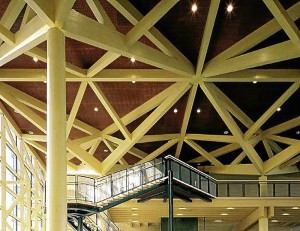Alternatives to local hardwood

THE WONDERS OF LOCAL HARDWOOD ALTERNATIVES. Arctic Forest Product’s Finnish Pine is used even for structural applications. Other wood alternatives, such as agglomerate timber, can be worked with by a carpenter, just like it were real timber.
Oops, we did it again. I was startled but not surprised, when I heard about the flash floods that wiped through Northern Mindanao. Finally, photos showed up on the newspapers a day or two later with what I dreaded: images of logs washed ashore, obviously those that came rampaging down the rivers with the rushing floodwater. I finally saw what I was expecting to see. So sad.
Every so many years, it’s the same tragic scenario: heavy rainfall, flash floods, deaths. It wasn’t too long ago when Typhoon Ondoy’s waters submerge 85 percent of Metro Manila, and before that in 2004, the mudslides and floods in Infanta, Quezon. And who’d forget the deadly floods in Leyte a few years prior to that? Other than the heavy rainfall, a common factor the calamities share is geography, the fact that the floods happened at land basins that cradled the mountain ranges. And of course, the main culprit, the star of our show, is the relentless illegal logger.
Precious trees
Whatever happened to the log ban? I can imagine him now—trekking shoes, jeans, chainsaw in hand, truck waiting downstream, and, very likely, protected by a political kingpin. The entity that denuded our forests, taking our precious trees from the watershed, remains at large. I was looking forward to a grand time bashing him here, but really, who in the end of the chain, are they cutting all that timber for?
I cringe every time contractors and flooring suppliers come to me offering—and even bragging of—a good supply of narra wood for projects. I get that wringing in the gut because I sometimes cannot believe that to this day, and after all the tragedies that have happened, they still peddle the very thing that when harvested collectively, can kill an entire village and more. It already has many times over. But they still don’t get it. Nor do many others.
Article continues after this advertisementWhat we don’t realize every time we use local hardwood is that a sapling takes at least five years to mature into an amply sized arm of timber. Ideally though, it should be given 20 to 25 years to grow into truly mature logs. We don’t seem to comprehend that it literally takes decades to grow timber to a size where it has also grown its roots sufficiently long and plenty enough to latch on to the soil, and deep enough to take its water, so that the soil is always permeable and held down and will not come down with rainwater in a torrent of flood during a heavy downpour.
Article continues after this advertisementUnlike developed countries, our local hardwood industry is so badly regulated, that it is difficult to verify the truthfulness of claims by sellers of old or recycled wood. There is no system of certifying used timber. Neither is there a credible system of certifying wood grown from tree farms, quite a long shot for us, since this approach of farming timber is quite new in this country.
Tested options
To be fair, there are people who so badly want to use hardwood alternatives, but don’t know where to start looking. The current market presents many products that are alternatives to local hardwood, mostly made of tree-farmed timber, or of treated real wood, or of composite wood material. For starters, here’s a short list of tested options to explore:
Arctic-Forest Products Inc. sells certified tree-farmed, treated evergreen Scots Pine, the most common native tree in Finland. Their timber can be used for general timber construction work, both as structural and decorative or finishing timber like framing, paneling and flooring. Contact them through Tel. +632-4427580, Telefax +632-3327566 or send e-mail to: [email protected].
Kaufman Stones and Floors sells a wood agglomerate that works as an excellent substitute for natural wood. The material can be worked and treated like any natural timber product, and is probably more long-lasting considering its semi-synthetic quality. Contact them through Tel. +632-4427580, Telefax +632-3327566 or send e-mail to [email protected].
Central Lumber Corp. sells Armorwood, a natural timber from Radiata Pine which is tree-farmed in New Zealand. It is prepared with a high-pressure treatment that keeps it from rotting or termite invasion. Contact them through Tel. +632-4427580, Telefax +632-3327566 or send e-mail at [email protected].
Don’t preach yourself to be a nature lover while you harbor local hardwood flooring, like our beloved narra, sourced and installed not too long ago. There’s already too much “greenwashing” in the building industry. Until we realize that cumulatively, we cause the problem, there will be no end to the mudslides, the floods and the deaths. Or maybe, which could be the saddest truth—we really just don’t care.
Contact the author through [email protected] or through our Asuncion Berenguer Facebook account.